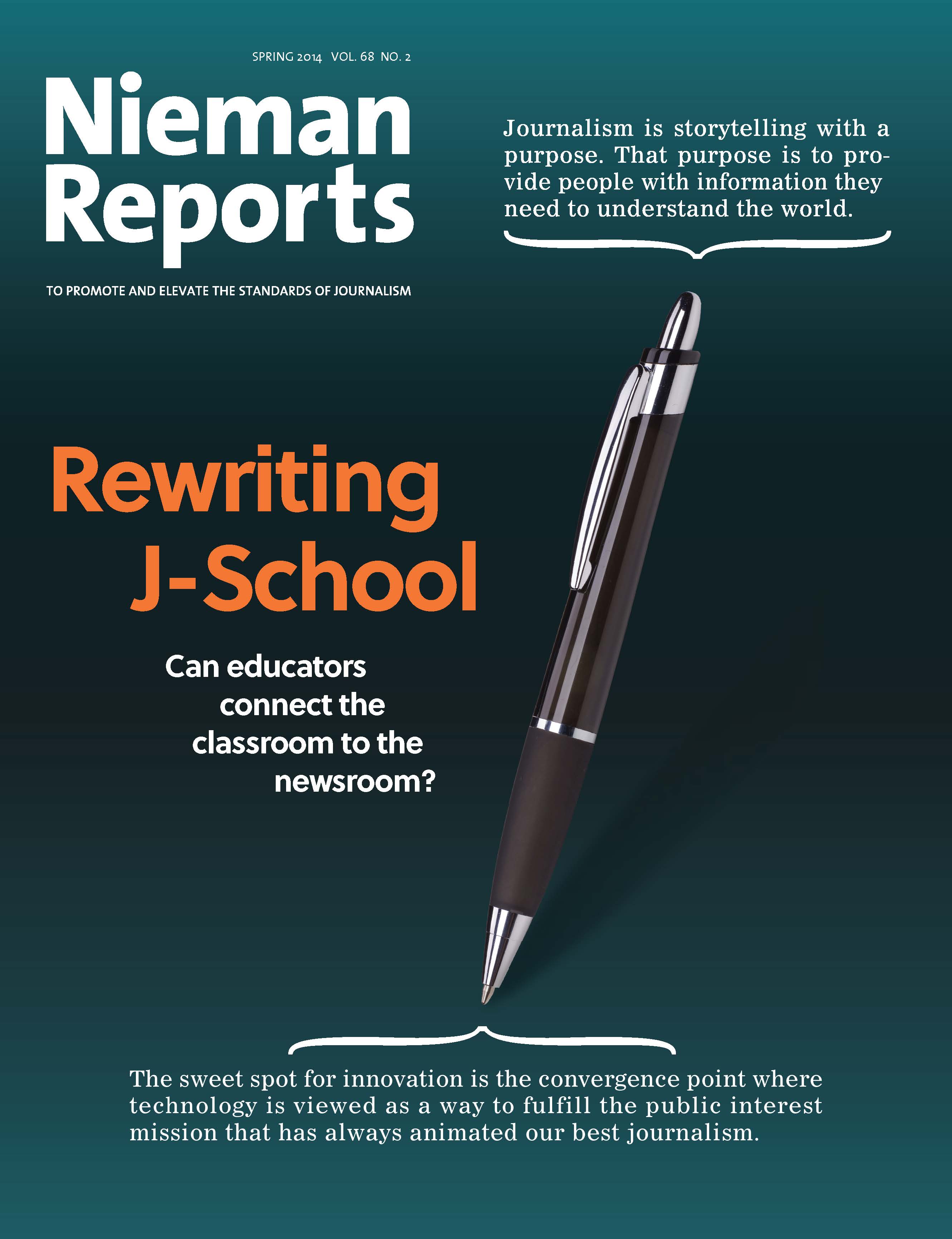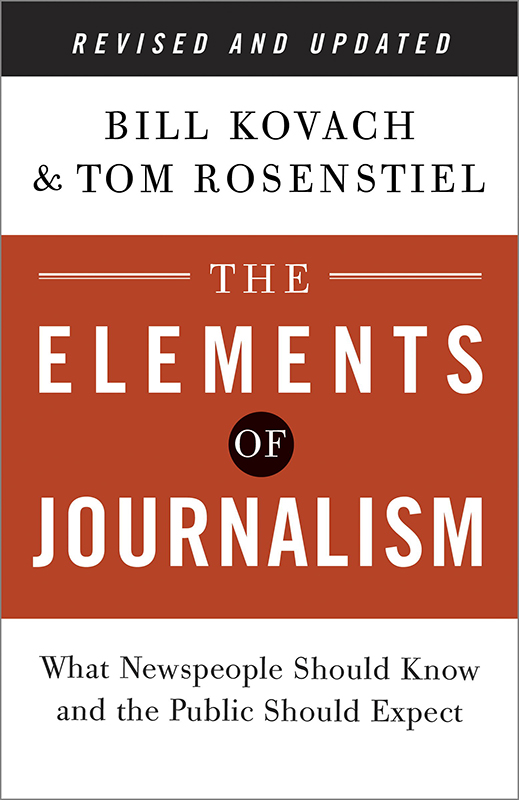
Audiences used to have to adapt to the media’s publication cycles; today, media must find ways to adapt to readers’ schedules
Since its publication in 2001, “The Elements of Journalism” has been the industry-standard text on the ethics and practice of journalism. In this edited excerpt from the third edition, published this past April, co-authors Bill Kovach and Tom Rosenstiel explore ways that journalists can harness some of these new tools in service of the book’s seventh principle: Journalism must make the significant interesting and relevant.
Engagement requires that journalists understand a new, deeper structural reality: In the old order, audiences had to adapt their behavior to fit the rhythms of the news media. They had to be home at 6:30 to see the newscast, or be sure to read the morning paper to be current with the news others had seen. Now the news media must adapt to fit the behavior and curiosity of the community that new technology has created. Now that audiences can go elsewhere with ease, they will increasingly demand that journalists make the best choices about how much and what kind of information to provide and not provide, given that arbitrary space limits are not an issue.
Rethinking is required in part because some of the conventional wisdom about shortened attention spans was misguided and has hurt journalism. A multiyear study of local television news we designed at the Project for Excellence in Journalism, for instance, found that stations that ran more short stories—under 45 seconds—tended to lose audiences. Stations that did more stories over two minutes, on the other hand, tend to gain viewership.
Similarly, many early studies suggested that people would never read long-form material on digital screens. The average time people spent on Web pages tended toward about 30 seconds, according to studies by the Poynter Institute. The advent of the smartphone, tablet and e-reader began to dispel this illusion. The short attention span had less to do with anything inherent about the screens than it did with the fact that the people in the studies were using desktop computers, and often in their offices.
The good news is that the same technology that devastated the economic foundation of commercial news in the beginning of the new century has also unleashed a profound new wave of creativity. The tools include new ways of using data, graphics and technology, involving the community, and more. The level of experimentation is probably unprecedented in at least a century, and while dizzying to many older hands, it offers the potential to make journalism more engaging, more relevant, and more empowering than in generations. Here are [two] conceptual approaches to doing so:
News as structured data
The rich new wealth of data made possible by the Web can be rendered in ways that go beyond narratives about data or even the largely visual representations of numbers. One of these alternatives is to structure the information into new constructed data points that tell the story. This is data that is organized and analyzed into points of meaning beyond raw data.
PolitiFact, a website run by the Tampa [Bay] Times, the focus of which is political “fact checking,” is an example. Rather than write stories, the site rates the veracity of statements by political figures on a meter, from true to utterly false. Each rating, in effect, is a data point. These data points, in turn, can be combined to tell other stories over time, like charting the overall truthfulness of Barack Obama’s statements and comparing his to other officials’.
Homicide Watch, a website that tracks crime in cities at the street level, does something similar. Information is logged as data points, not just narrative, and that data can be sorted, mapped, filtered and analyzed in a comprehensive way over time.
The potential here is far greater than most news organizations realize. When print publications went digital, every story necessarily transformed from words on a page into a data record in a CMS database. Generally, however, few of these stories were treated as data that could be related to one another and analyzed programmatically. As an example, when newspapers posted to the Web real estate transactions that were printed in the paper, the different data points about location, price and buyer could have been entered into different data fields, such as school districts, tax assessments, access to public transportation. If they had been, the potential for understanding and analyzing that data would have grown exponentially. The paper would no longer just have stories archived. It would have knowledge about the community that could be used in different ways.
Turning news into data opens up profound new potential for creating a more deeply informed and engaged audience. Even news operations with fairly limited resources can analyze the data to do more insightful, efficient reporting. The data can be made sortable and interactive, for users to manipulate. News organizations can build news apps and mobile apps that leverage the data, and news coded and treated as data can be leveraged into new revenue. Both PolitiFact and Homicide Watch, for example, are making money by licensing their technology platform to other news organizations.
Multimedia that’s multi-media
A growing number of places are experimenting with Web-native storytelling forms that blend video, audio, images, text, animations and interactive graphics into one integrated narrative.
In this new form of storytelling, each piece of content involves multimedia dimensions. It’s not a text story with a video embedded, or slide shows with text. Rather, these are new kinds of narratives that can’t be clearly defined by their components, or even, admittedly, described here with words.
Zeega.com, for instance, is a website that enables anyone to easily combine animated GIFs, audio, images, text and video from across the Web. Cowbird is another site that does something similar. Explore them and you will find video of the space race, narrated by astronaut Frank Borman, which users control by clicking, and collages of images with written text in different fonts, and animations with audio narration. There are no set norms, and most visitors will find some stories stimulating and others flat. Whether it’s work by professionals such as Alexis Madrigal of The Atlantic or work by amateurs of all ages, there is only a single common denominator on Cowbird: creativity.
The New York Times received wide praise for its 2013 blending of elements in telling the story of the avalanche at Tunnel Creek in Washington State’s Cascade Mountain range. The rich and skilled rendering of the incident that trapped and killed experienced skiers indicates the promise of multimedia, but it is hardly alone. Prison Valley is the interactive Web story of a town in the middle of Colorado with 13,000 people—and 13 prisons—that is almost the meeting of television documentary and video game. NPR’s Picture Show, a daily curation of photos from around the Web, produced a special report called “Lost and Found” that blended rare color photographs shot by amateur photographer Charles Cushman in 1938 with audio narration and the story of how his lost photos were discovered.
As we discuss technique, it is vital to take care to remember that form never determines substance. Technique should never alter the facts—the journalist’s use of narrative forms must always be governed by the principles of accuracy and truthfulness. Regardless of the form of presentation, the most engaging thing of all must be kept in mind: The story is true.
Reprinted from “The Elements of Journalism,” Revised and Updated 3rd Edition, by Bill Kovach and Tom Rosenstiel. Copyright © 2014 by Bill Kovach and Tom Rosenstiel




